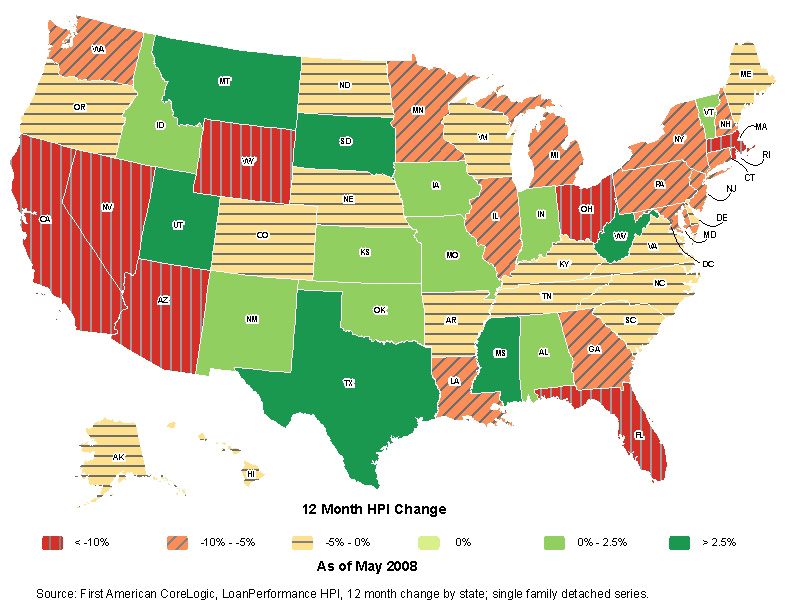
Analyzing the 2008 U.S. Housing Market: A State-by-State Breakdown of Price Changes
In May 2008, the U.S. housing market was still reeling from the effects of the subprime mortgage crisis that precipitated a nationwide economic downturn. An examination of the 12-month House Price Index (HPI) change during this period reveals a varied landscape of housing price adjustments across the country, providing insight into the regional impacts of the crisis.
The HPI Change Landscape
The House Price Index is a broad measure used to estimate the price changes in residential housing markets. The map provided for May 2008 shows a diverse pattern of HPI changes across the United States:
- Deep Declines in the West: States like California, Nevada, and Arizona experienced the steepest declines, with HPI changes surpassing -10%. This reflects the significant overvaluation of properties that occurred in these states leading up to the crisis.
- Moderate to Mild Decreases: Many states, primarily in the Midwest and the Northeast, saw moderate to mild decreases in housing prices, ranging from -5% to 0%.
- Stability and Growth: A few states, particularly in the central U.S., including North Dakota, South Dakota, and Texas, remained stable or experienced growth in housing prices, indicating a more resilient housing market.
Factors Influencing the Varied HPI Changes
Several factors contributed to the state-by-state differences in housing price changes:
- Economic Diversification: States with more diversified economies tended to weather the crisis better than those heavily reliant on real estate and construction.
- Speculative Investment: Areas with high levels of speculative investment in real estate before the crisis, such as California and Florida, were hit hardest by the downturn.
- Foreclosure Rates: States with higher foreclosure rates, often due to higher rates of subprime lending, saw more significant price declines.
- Local Economic Conditions: The local economic conditions, including employment rates and income levels, also played a crucial role in housing market stability.
The Broader Economic Impact
The variation in HPI changes across states highlights the uneven economic impact of the housing crisis:
- Regional Economic Health: States with declining HPI faced broader economic challenges, including higher unemployment rates and decreased consumer spending.
- Mortgage Market Stress: The more significant price declines put additional stress on the mortgage market, increasing the risk of loan defaults and foreclosures.
- Policy Response: The varied HPI changes required targeted policy responses, as a one-size-fits-all approach would not address the specific needs of each state.
Conclusion
The map of the 12-month HPI change as of May 2008 serves as a visual representation of the housing market challenges during a critical period of economic uncertainty. The disparities in housing price trends underscore the importance of region-specific economic analysis and policy-making. They also reflect the complexity of the housing market crisis, which had deep-rooted causes and far-reaching consequences, varying significantly from one state to another. As the country moved forward from the crisis, these HPI changes provided valuable lessons for investors, policymakers, and economic analysts alike.

Too discrete to give his real age (but certainly in the grizzled veteran bracket), Tom is an Army brat who spent much of his childhood overseas. After moving back to Florida in the 80’s with his family, Tom worked a variety of jobs after college before finding his calling in the mortgage industry. Now, adding his decades worth of experience to this site, Tom hopes to help others with his knowledge.
After working through the 2008 crisis in a hard hit bank, Tom knows only too well the impact his industry has on people’s lives. Now semi-retired, Tom spends his days keeping up with the latest news in the mortgage industry (and finding the odd hour or three to fish).